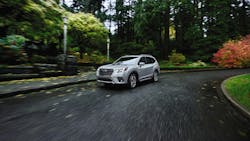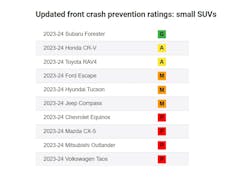Few Small SUVs Excel in New IIHS Front Crash Prevention Test
In the first round of evaluations of small SUVs, by the Insurance Institute for Highway Safety (IIHS), only one of 10 small SUVs, the Subaru Forester, earned a good rating, according to a news release.
The IIHS is introducing a more rigorous vehicle-to-vehicle front crash prevention test. The updated test will address high-speed crashes and those involving motorcycles or large trucks.
“This is a vital update to one of our most successful test programs,” IIHS President David Harkey said. “The vast majority of new vehicles now come with automatic emergency braking, and our research shows the technology prevents as many as half of all front-to-rear crashes. This new, tougher evaluation targets some of the most dangerous front-to-rear crashes that are still happening.”
The Honda CR-V and Toyota RAV4 were rated acceptable, while the Ford Escape, Hyundai Tucson, and Jeep Compass received marginal ratings. The Chevrolet Equinox, Mazda CX-5, Mitsubishi Outlander, and Volkswagen Taos were all rated poor.
The original front crash prevention test, which focused on low-speed crashes and was discontinued at the end of 2022, was developed when the technology was relatively new. All tested vehicles were earning the top rating of superior by the time the original evaluation ended.
Despite real-world data suggesting that front crash prevention is reducing higher-speed crashes, the original test did not measure the performance of specific systems at higher speeds. Additional IIHS research also found that current systems are less effective at preventing crashes with motorcycles and medium or heavy trucks than with other passenger vehicles.
A Tougher Test
To address these issues, the updated test now includes trials run at 31, 37, and 43 mph (50, 60, and 70 kilometers per hour), instead of the earlier 12 and 25 mph speeds. It examines performance with a passenger car target, a motorcycle target, and a semitrailer. As a result, the new evaluation reflects a substantially larger proportion of police-reported front-to-rear crashes, including many that are more severe.
“Crashes that occur at higher speeds are obviously more dangerous,” said IIHS Senior Research Scientist David Kidd, who led the development of the new evaluation. “Deadly underride crashes often occur when the struck vehicle is a large truck. Motorcyclists are frequently killed when they’re rear-ended by a passenger car, as their bike offers no protection from the impact.”
In the new evaluation, multiple trials are conducted with a target representing a passenger car, a target representing a motorcycle, and an actual dry van trailer. Tests are run at all three speeds with each vehicle type. The tests using surrogates are conducted with the motorcycle or passenger car target positioned in the center of the travel lane and offset to the left or right, while the trailer is always positioned in the center of the lane.
The trials using targets evaluate both the forward collision warning and automatic emergency braking (AEB) systems. In each test run, an engineer drives the test vehicle toward the target at the selected speed and records when the forward collision warning occurs and how much the AEB system slows the vehicle to prevent or mitigate the impending impact. If the test vehicle fails to achieve a minimum speed reduction at the slower test speeds, only the forward collision warning system is evaluated in the higher-speed tests.
In all the test runs using the trailer, only the forward collision warning system is evaluated, and the driver steers out of the lane to avoid a crash.
Evaluating Performance
Points are awarded for warnings that occur at least 2.1 seconds before the projected time of impact and for substantial speed reductions in the AEB tests. Speed reductions account for two-thirds and warnings account for one-third of the maximum possible score.
The good-rated Forester avoided a collision with the passenger car target at every test speed, avoided hitting the motorcycle target at 31 and 37 mph, and slowed by an average of 30 mph before hitting the motorcycle target in the 43 mph tests. The forward collision warning alerts also came more than the required 2.1 seconds before the projected time of impact in all those trials and also in those conducted with the trailer.
The acceptable-rated CR-V provided a timely forward collision warning alert and came to a stop or near stop in every trial with the passenger car target and in the 31 and 37 mph trials with the motorcycle target. However, it failed to slow consistently in the 43 mph trials with the motorcycle target.
Even vehicles with a marginal rating in the new test demonstrate a higher level of performance than what was required for the highest rating in the original vehicle-to-vehicle front crash prevention evaluation.
For example, the Escape avoided hitting the passenger car and motorcycle targets at the 31 mph test speed and slowed by a modest amount in the higher speed tests, regardless of where the targets were positioned. However, it lost several points because its forward collision warning came too late in all of the 31 mph tests.
The four poor-rated vehicles fell short in multiple test scenarios.
For example, the Equinox provided a timely forward collision warning in the tests with the trailer and passenger car target but either failed to give a warning or gave it too late in most tests with the motorcycle target. With the passenger car target, it slowed modestly in the 31 mph tests, and with the motorcycle target it barely reduced speed at all.
About the Author
FenderBender Staff Reporters
The FenderBender staff reporters have nearly four decades of combined journalism and collision repair experience.

